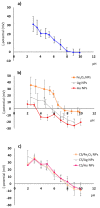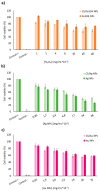Ionotropic Gelation-Based Synthesis of Chitosan-Metal Hybrid Nanoparticles Showing Combined Antimicrobial and Tissue Regenerative Activities
- PMID: 34833209
- PMCID: PMC8618652
- DOI: 10.3390/polym13223910
Ionotropic Gelation-Based Synthesis of Chitosan-Metal Hybrid Nanoparticles Showing Combined Antimicrobial and Tissue Regenerative Activities
Abstract
The treatment of skin wounds poses significant clinical challenges, including the risk of bacterial infection. In particular due to its antimicrobial and tissue regeneration abilities chitosan (a polymeric biomaterial obtained by the deacetylation of chitin) has received extensive attention for its effectiveness in promoting skin wound repair. On the other hand, due to their intrinsic characteristics, metal nanoparticles (e.g., silver (Ag), gold (Au) or iron oxide (Fe3O4)) have demonstrated therapeutic properties potentially useful in the field of skin care. Therefore, the combination of these two promising materials (chitosan plus metal oxide NPs) could permit the achievement of a promising nanohybrid with enhanced properties that could be applied in advanced skin treatment. In this work, we have optimized the synthesis protocol of chitosan/metal hybrid nanoparticles by means of a straightforward synthetic method, ionotropic gelation, which presents a wide set of advantages. The synthesized hybrid NPs have undergone to a full physicochemical characterization. After that, the in vitro antibacterial and tissue regenerative activities of the achieved hybrids have been assessed in comparison to their individual constituent. As result, we have demonstrated the synergistic antibacterial plus the tissue regeneration enhancement of these nanohybrids as a consequence of the fusion between chitosan and metallic nanoparticles, especially in the case of chitosan/Fe3O4 hybrid nanoparticles.
Keywords: antimicrobial; biomedical applications; chitosan; gold; iron oxide; nanoparticles; nanotechnology; silver; skin regeneration; wound healing.
Conflict of interest statement
The authors declare no conflict of interest.
Figures







Similar articles
-
Enhanced Wound Healing With β-Chitosan-Zinc Oxide Nanoparticles: Insights From Zebrafish Models.Cureus. 2024 Sep 21;16(9):e69861. doi: 10.7759/cureus.69861. eCollection 2024 Sep. Cureus. 2024. PMID: 39435246 Free PMC article.
-
Green Synthesis of Chitosan-Silver/Gold Hybrid Nanoparticles for Biomedical Applications.Methods Mol Biol. 2019;2000:79-84. doi: 10.1007/978-1-4939-9516-5_7. Methods Mol Biol. 2019. PMID: 31148010
-
Nanotechnology as a therapeutic tool to combat microbial resistance.Adv Drug Deliv Rev. 2013 Nov;65(13-14):1803-15. doi: 10.1016/j.addr.2013.07.011. Epub 2013 Jul 24. Adv Drug Deliv Rev. 2013. PMID: 23892192 Review.
-
Multifunctional Silver Nanoparticles Based on Chitosan: Antibacterial, Antibiofilm, Antifungal, Antioxidant, and Wound-Healing Activities.J Fungi (Basel). 2022 Jun 8;8(6):612. doi: 10.3390/jof8060612. J Fungi (Basel). 2022. PMID: 35736095 Free PMC article.
-
Adsorption of Silver Nanoparticles onto Different Surface Structures of Chitin/Chitosan and Correlations with Antimicrobial Activities.Int J Mol Sci. 2015 Jun 18;16(6):13973-88. doi: 10.3390/ijms160613973. Int J Mol Sci. 2015. PMID: 26096004 Free PMC article. Review.
Cited by
-
Polysaccharide nanoparticles as building blocks for food processing applications: A comprehensive review.Food Sci Biotechnol. 2024 Sep 23;34(3):527-546. doi: 10.1007/s10068-024-01695-w. eCollection 2025 Feb. Food Sci Biotechnol. 2024. PMID: 39958179 Review.
-
Fe3O4 Magnetic Nanoparticles Obtained by the Novel Aerosol-Based Technique for Theranostic Applications.Materials (Basel). 2023 Sep 29;16(19):6483. doi: 10.3390/ma16196483. Materials (Basel). 2023. PMID: 37834621 Free PMC article.
-
Carboplatin Co-loaded 5-Fluorouracil Nanoparticles Conjugated with Trastuzumab for Targeted Therapy in HER2+ Heterogeneity Breast Cancer.AAPS PharmSciTech. 2025 Apr 25;26(5):114. doi: 10.1208/s12249-025-03107-6. AAPS PharmSciTech. 2025. PMID: 40281210
-
Electrospraying as a Technique for the Controlled Synthesis of Biocompatible PLGA@Ag2S and PLGA@Ag2S@SPION Nanocarriers with Drug Release Capability.Pharmaceutics. 2022 Jan 17;14(1):214. doi: 10.3390/pharmaceutics14010214. Pharmaceutics. 2022. PMID: 35057109 Free PMC article.
References
-
- Marciello M., Pellico J., Fernandez-Barahona I., Herranz F., Ruiz-Cabello J., Filice M. Recent advances in the preparation and application of multifunctional iron oxide and liposome-based nanosystems for multimodal diagnosis and therapy. Interface Focus. 2016;6:20160055. doi: 10.1098/rsfs.2016.0055. - DOI - PMC - PubMed
-
- Erami R.S., Ovejero K., Meghdadi S., Filice M., Amirnasr M., Rodriguez-Dieguez A., de La Orden M.U., Gomez-Ruiz S. Applications of nanomaterials based on magnetite and mesoporous silica on the selective detection of zinc ion in live cell imaging. Nanomaterials. 2018;8:434. doi: 10.3390/nano8060434. - DOI - PMC - PubMed
-
- Sanchez A., Ovejero Paredes K., Ruiz-Cabello J., Martinez-Ruiz P., Pingarron J.M., Villalonga R., Filice M. Hybrid decorated core@ shell janus nanoparticles as a flexible platform for targeted multimodal molecular bioimaging of cancer. ACS Appl. Mater. Interfaces. 2018;10:31032–31043. doi: 10.1021/acsami.8b10452. - DOI - PubMed
-
- Vinambres M., Filice M., Marciello M. Modulation of the catalytic properties of lipase b from candida antarctica by immobilization on tailor-made magnetic iron oxide nanoparticles: The key role of nanocarrier surface engineering. Polymers. 2018;10:615. doi: 10.3390/polym10060615. - DOI - PMC - PubMed
Grants and funding
LinkOut - more resources
Full Text Sources
Research Materials

